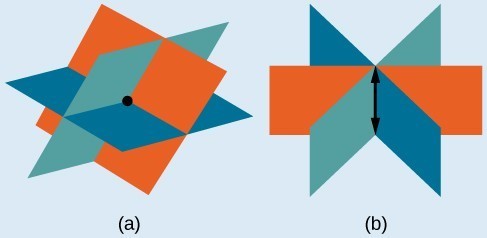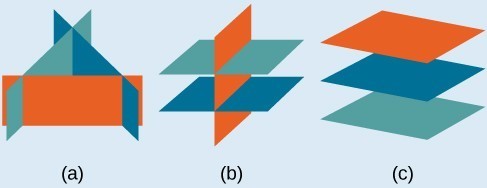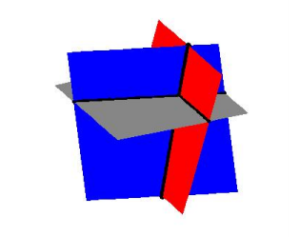Learning Outcomes
- Determine whether an ordered triple is a solution to a system of three equations.
- Use back substitution to find a solution to a system of three equations.
- Write the equations for a system given a scenario, and solve.
In order to solve systems of equations in three variables, known as three-by-three systems, the primary goal is to eliminate one variable at a time to achieve back-substitution. A solution to a system of three equations in three variables [latex]\left(x,y,z\right),\text{}[/latex] is called an ordered triple.
To find a solution, we can perform the following operations:
- Interchange the order of any two equations.
- Multiply both sides of an equation by a nonzero constant.
- Add a nonzero multiple of one equation to another equation.
Graphically, the ordered triple defines the point that is the intersection of three planes in space. You can visualize such an intersection by imagining any corner in a rectangular room. A corner is defined by three planes: two adjoining walls and the floor (or ceiling). Any point where two walls and the floor meet represents the intersection of three planes.
A General Note: Number of Possible Solutions
The planes illustrate possible solution scenarios for three-by-three systems.
- Systems that have a single solution are those which, after elimination, result in a solution set consisting of an ordered triple [latex]\left\{\left(x,y,z\right)\right\}[/latex]. Graphically, the ordered triple defines a point that is the intersection of three planes in space.
- Systems that have an infinite number of solutions are those which, after elimination, result in an expression that is always true, such as [latex]0=0[/latex]. Graphically, an infinite number of solutions represents a line or coincident plane that serves as the intersection of three planes in space.
- Systems that have no solution are those that, after elimination, result in a statement that is a contradiction, such as [latex]3=0[/latex]. Graphically, a system with no solution is represented by three planes with no point in common.

(a)Three planes intersect at a single point, representing a three-by-three system with a single solution. (b) Three planes intersect in a line, representing a three-by-three system with infinite solutions.

Example: Determining Whether an Ordered Triple Is a Solution to a System
Determine whether the ordered triple [latex]\left(3,-2,1\right)[/latex] is a solution to the system.
[latex]\begin{array}{l}\text{ }x+y+z=2\hfill \\ 6x - 4y+5z=31\hfill \\ 5x+2y+2z=13\hfill \end{array}[/latex]
How To: Given a linear system of three equations, solve for three unknowns.
- Pick any pair of equations and solve for one variable.
- Pick another pair of equations and solve for the same variable.
- You have created a system of two equations in two unknowns. Solve the resulting two-by-two system.
- Back-substitute known variables into any one of the original equations and solve for the missing variable.
tip for success
Work through the following examples on paper in the order given. They slowly build up the technique of solving a three-by-three system in stages. Then you will have an opportunity to practice the 4-step process given in the How To box above.
Solving a system with three variables is very similar to solving one with two variables. It is important to keep track of your work as the addition of one more equation creates more steps in the solution process.
We’ll take the steps slowly in the following few examples. First, we’ll look just at the last step in the process: back-substitution. Then, we’ll look at an example that requires the addition (elimination) method to reach the first solution. Then we’ll see some video examples that illustrate some of the different kinds of situations you may encounter when solving three-by-three systems. Finally, you’ll have the opportunity to practice applying the complete process.
In the example that follows, we will solve the system by using back-substitution.
Example
Solve the given system.
[latex]\displaystyle\begin{cases}x-\dfrac{1}{3}y+\dfrac{1}{2}z=1\\\,\,\,\,\,\,\,\,\,\,\,\,\,\,y-\dfrac{1}{2}z=4\\\,\,\,\,\,\,\,\,\,\,\,\,\,\,\,\,\,\,\,\,\,\,\,\,\,\,z=-1\end{cases}[/latex]
In the following video, we show another example of using back-substitution to solve a system in three variables.
In the next example we’ll need to use the addition method (elimination) to find our first solution.
Example
Find a solution to the following system:
Watch the following videos for more examples of the algebra you may encounter when solving systems with three variables.
Now, try the example and problems that follow to see if the process is becoming familiar to you. Solving three-by-three systems involves both creativity and careful, well-organized work. It will take some practice before it begins to feel natural.
Example: Solving a System of Three Equations in Three Variables by Elimination
Find a solution to the following system:
[latex]\begin{align}x - 2y+3z=9& &\text{(1)} \\ -x+3y-z=-6& &\text{(2)} \\ 2x - 5y+5z=17& &\text{(3)} \end{align}[/latex]
Try It
Solve the system of equations in three variables.
[latex]\begin{array}{l}2x+y - 2z=-1\hfill \\ 3x - 3y-z=5\hfill \\ x - 2y+3z=6\hfill \end{array}[/latex]
In the following video, you will see a visual representation of the three possible outcomes for solutions to a system of equations in three variables. There is also a worked example of solving a system using elimination.
Applications of Systems of Three Equations in Three Variables
Now we are ready to handle the problem we encountered as we began this section by using what we know about linear equations to translate the situation into a system of three equations. Then, we’ll use our new understanding of three-by-three systems to find the solution.
Tip for success
Applications of three-by-three systems are complicated. Work through each of the examples below perhaps more than once or twice. Don’t be discouraged if you don’t understand the process right away. It will take time and practice to become familiar with it.
Example: Solving a Real-World Problem Using a System of Three Equations in Three Variables
In the problem posed at the beginning of the section, John invested his inheritance of $12,000 in three different funds: part in a money-market fund paying 3% interest annually; part in municipal bonds paying 4% annually; and the rest in mutual funds paying 7% annually. John invested $4,000 more in mutual funds than he invested in municipal bonds. The total interest earned in one year was $670. How much did he invest in each type of fund?
Try It
Systems of three equations in three variables apply to other types of real-world situations as well.
In this example, we will write three equations that model sales at an art fair to learn how many prints should be sold to break even for the cost of the booth rental.
Example
Andrea sells photographs at art fairs. She prices the photos according to size: small photos cost [latex]$10[/latex], medium photos cost [latex]$15[/latex], and large photos cost [latex]$40[/latex]. She usually sells as many small photos as medium and large photos combined. She also sells twice as many medium photos as large. A booth at the art fair costs [latex]$300[/latex].
If her sales go as usual, how many of each size photo must she sell to pay for the booth?
In the following video example, we show how to define a system of three equations in three variables that represents a mixture needed by a chemist.
Our last example shows you how to write a system of three equations that represents ticket sales for a theater that has three different prices for tickets.
Candela Citations
- Revision and Adaptation. Provided by: Lumen Learning. License: CC BY: Attribution
- College Algebra. Authored by: Abramson, Jay et al.. Provided by: OpenStax. Located at: http://cnx.org/contents/9b08c294-057f-4201-9f48-5d6ad992740d@5.2. License: CC BY: Attribution. License Terms: Download for free at http://cnx.org/contents/9b08c294-057f-4201-9f48-5d6ad992740d@5.2
- Question ID 23765. Authored by: Shahbazian,Roy. License: CC BY: Attribution. License Terms: IMathAS Community License CC-BY + GPL
- Systems of Equations in Three Variables: Part 1 of 2 . Authored by: Sousa, James (Mathispower4u.com). Located at: https://youtu.be/wIE8KSpb-E8. License: CC BY: Attribution
- System of 3 Equations with 3 Unknowns Application - Concentration Problem. Authored by: James Sousa (Mathispower4u.com). Located at: https://youtu.be/612Ad0W9ZeY. License: CC BY: Attribution
- System of 3 Equations with 3 Unknowns Application - Ticket Sales. Authored by: James Sousa (Mathispower4u.com) . Located at: https://youtu.be/Wg_v5R7BFo0. License: CC BY: Attribution


